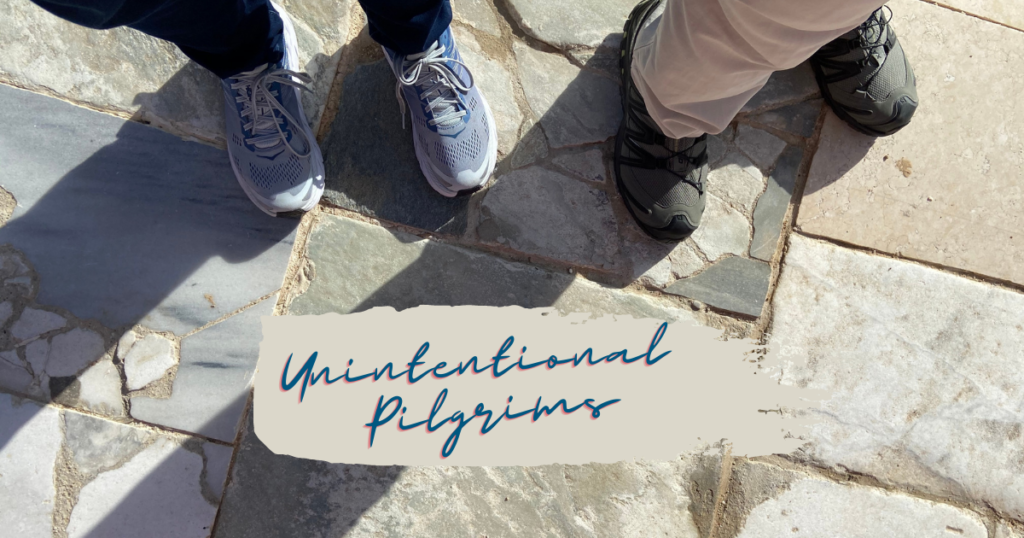My Quest for Hallowed Ground
I was absorbing everything at once around me but understanding almost nothing. Grateful that our luggage made it to Tel-Aviv with us, we were scurried by our tour guide to the bus. I stepped up into the friendly red bus, an act that would be repeated multiple times a day for twelve days. I had no comprehension with that first step that I was accidentally embarking on a pilgrimage. And so, my unintentional quest for hallowed ground among the ancient stones began.
The northern region, Galilee, would be our introduction to all things ancient, historical, and geographical about Israel. We were there to experience, not just trace, the footsteps of Jesus and recall the Old Testament stories of the Patriarchs.
Ancient stones marked our way.
One after another, I slide my fingertips slowly across their surface. Walking further, I continued my survey of the ancient landscape and structures surrounding me. I stopped, wondered, and touched them again.
“Cold and Hard,” my senses replied.
I stood on massive stones, walked on and between the stones, and took hundreds of pictures of ancient stones. Whether I sat on them or climbed up them, it was the same at each site where we stopped. I would linger, momentarily as our group proceeded, to touch them just once more.
Again, my senses replied with full confidence: “Cold and Hard.”
Standing at the crossroads of world history, I would rest the palm of my hand in full contact with the side and top of huge stones. These giants had been chiseled, built into walls and gates, and hewn into stairways thousands of years ago. But the January rain could only add this to my sensory report:
“Slippery, beware of falling.”
These stones stood as sentinel witnesses to the peoples who had lived and died here. But these markers of epochs were jointly bound to resolute silence. They could not testify to a single battle that had been fought, lost, or won, while humankind had travailed in their midst.
Every stone felt the same, cold and hard.
Each stone was silent.
Cold. Hard. Silent.
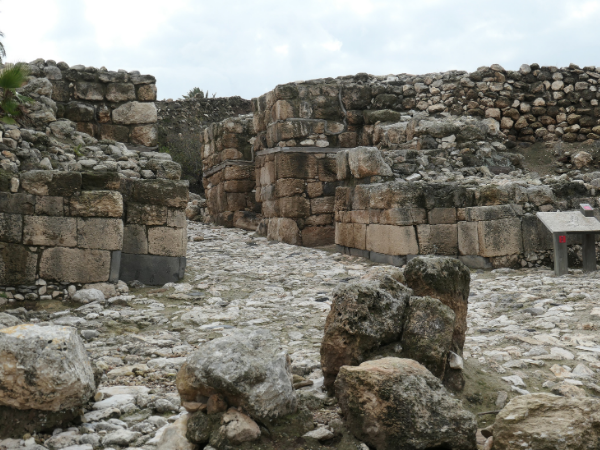 The Ancient Ruins of Dan
The Ancient Ruins of Dan
Without our excellent tour guide, Naomi, I would have been lost and uninformed.
Accidental Pilgrims
Pilgrims, some locals called us. I chuckled inside at the sound of that word. After two decades of researching my Pilgrim 10th great-grandparents who journeyed to Massachusetts 400 years ago, someone was calling me a “Pilgrim!” What a novel thought.
I had accidentally become a pilgrim.
How fitting it seemed for me to be among a group of pilgrims in Israel. They added us to the chronicles of the faithful who had come on a pilgrimage, seeking a land of promise, a holy land – a place to be revered and relished, with hope, healing, and peace. The relics had already been carried away.
What could modern pilgrims hope for? Something spiritual, an encounter? Perhaps making a connection with the historical and cultural background of Jesus’ earthly life would be our sole allotment.
This trip had never been on my bucket list. I once spent three years living on the outskirts of Athens, Greece. Ample time had been devoted to walking on streets where Paul, the apostle, had walked and taught in Corinth, Athens, and Thessaloniki. I knew before I boarded the plane that ancient stones quickly begin to all look alike.
There was no compelling reason for my husband and me to be on this tour of Israel. Our schedule for the upcoming year was filled with other commitments and travel. The Israel trip opportunity came up unexpectedly. We kept looking for a good reason to say no. “It will be a life-changing trip,” friends encouraged us. “Quit thinking about and do it,” trusted mentors told us.
Having never done a group tour (especially a two weeklong overseas tour), we had hesitantly signed up. Interesting and educational, perhaps even amazing, were the descriptors of my pre-trip expectations. After all, I would walk where Jesus had walked. Maybe (I sincerely hoped) I could see some shepherds near Bethlehem and a real manger, unlike the fakes of our commercial nativity scenes.
My life had already been transformed by Jesus,
therefore, “life-changing” was not among my trip descriptors.
Despite that lack of expectation, my innate curiosity could not be dampened as we traversed the Biblical sites in Galilee. The fiery power of God had descended on Mt. Carmel when Elijah had prayed, and the prophets of Baal were defeated. As we stood at that mountaintop shrine, we also overlooked the valley of Armageddon and tried to imagine the cataclysmic future battle that will be fought there.
The cold wind and rain scurried our shivering pilgrim band back to the warm tour bus. Up and down, we went on the curvy roads to view more history firsthand.
More ancient stones. More well-told stories. Our knowledge of Bible history took on a new context with each stop. How could so much be jam-packed into a land as small as Israel? And we were still on day one!
One thing did not change, though. My sensory report at each stop remained:
“Ancient stones: Cold and Hard.”
Was I missing something? Was I just being coldly hard-hearted?
Where was the mystical, the mesmerizing, the feeling of the intangible?
Jesus had walked here. Everyone else that I had read of in my beloved Bible throughout my entire life had been right in the spots where my feet were stepping!
For heaven’s sake, shouldn’t I feel something?
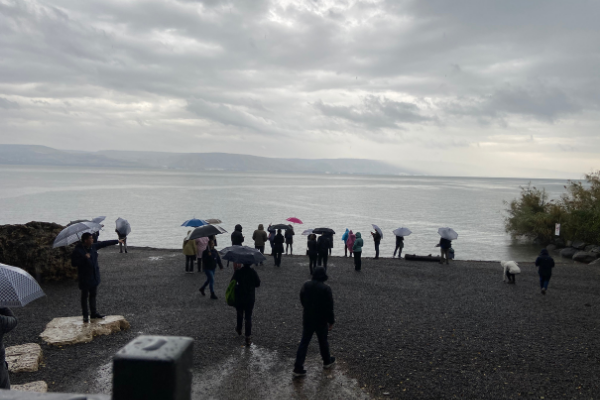
Sea of Galilee’s wet, cold pebbles
Recalibrating my “hallowed” expectations
I remember stopping at the seaside memorial, now called Peter’s Primacy. This familiar place along the shore of the Sea of Galilee had witnessed the multiplication of loaves and fishes to feed the 5000. Here also in this area, during the days after his resurrection, Jesus appeared again to his disciples who had fished all night unsuccessfully long. Jesus had prepared them a breakfast of fish and bread somewhere there along the shoreline. They ate and warmed themselves by his fire.
It warmed me to recall the scene. This was no Hallmark moment for His disciples, however. Inside this picturesque scene, Jesus posed his tripled, poignant question to a still remorseful Peter who had denied knowing Jesus on the night of His trial. “Peter, do you love me?” Shouldn’t Peter’s grief at that question prick my heart as well?
The rain could not dissuade me from crouching at the shoreline to dip my arm into the icy cold water that was lapping at my toes. My fingers tumbled a few pebbles around at the water’s edge.
If I thought it would have cured my arthritis, I would have made the full plunge! Alas, the group was moving on, and so did I. I fingered the pebble that was now in my pocket.
Silly girl, I thought to myself.
“What did you expect? A miracle?“
Each day we listened intently to Naomi’s skillful narrative. When weather permitted, we paused to hear the story told directly from scripture, as someone in the group read the pertinent Bible passage. We listened with newly opened eyes and ears. I gratefully patted the cold stone that provided a seat when the group paused for a devotional given by a pastor in our group.
Although I welcomed the break, my heart’s expectation was meager. I needed something more vibrant than the cold stones. Within a minute, I was recalibrating my wimpy expectations!
It was one of those, “Did I hear him right?” moments. How had he known to speak so directly to me? Who could have known how that one phrase, lifted straight from a familiar Bible passage, could penetrate and reassure my heart?
The warmth inside me was almost palpable.
But the stone I was sitting on was still:
Ancient. Cold. Hard.
The days of our tour ticked off too quickly. However, each day, we sensed an increase in our ability to perceive and understand the meaning behind what we touched, viewed, and experienced. This journey would become a personalized version of “Cliff Notes” annotations that would augment our bible reading and impact our life-living.
I could not deny it. The tour was exceeding my pre-trip expectations. Our companions were awesome – a mixture of ages and accents and dialects mostly from the Carolinas, Tennessee, and some Aussie gems!
My persistent but “hallowed” question
Still, my innate curiosity remained unsatisfied, wanting that nebulous something more. One thought haunted me:
“Where did this purported “hallowed ground” of the Holy Land live today?”
Along our way to the Dead Sea, I continued to watch and wonder. We met the flooding Jordan, climbed up to En Gedi’s falls, toured Masada, and more. All were wonderful. Yet, none satisfied my tenacious curiosity.
Perhaps it could be felt when we made it to Jerusalem the following week.
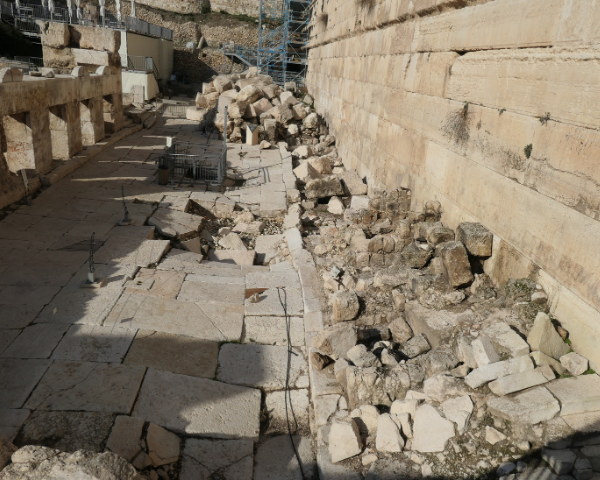
Ruins of ancient market shops by stone rubble
from 70AD temple destruction
I expectantly walked through Jerusalem. Each turn warranted more wide-eyed amazement. Massive was not a good enough descriptor for the stones we faced as we toured the area around the Temple mount. We crossed the Temple mount but kept our distance (as required) from the mosque. We could see but were not permitted to get too close or touch the spot where the Holy of Holies is thought to have stood (from the temple destroyed by the Romans in 70 A.D.)
Enriching as the moment was for our knowledge,
its holiness had long since departed.
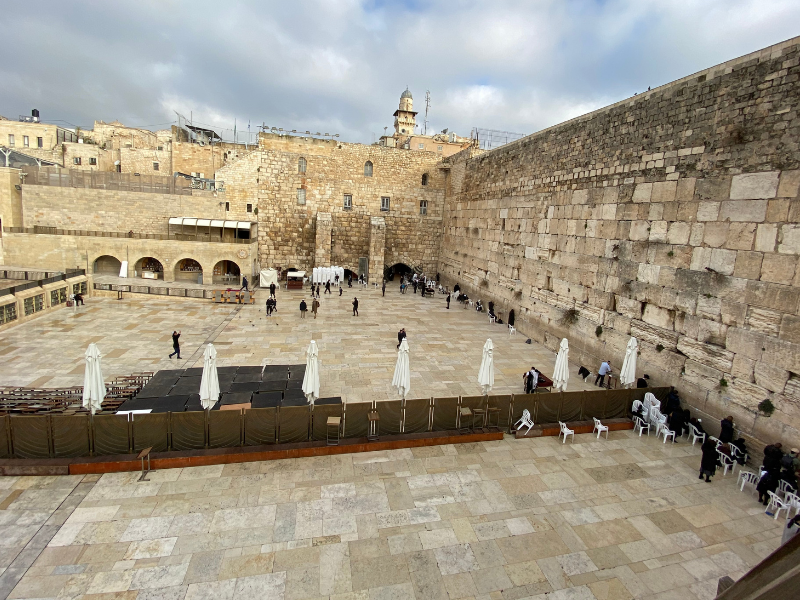
Overview of the Western Wall of the Temple Mount
Women’s smaller prayer area to the right of the dividers
Lessons from a Stone Wall
Later during our visit, I faced the Western Wall in the small (and now crowded) section designated for women to gather and pray while shielded from the view of the larger men’s area on the left. I prayed there among my sisters, where the faithful and pilgrims from many nations gather still.
I waited for my turn to step up to the wall and wedged in shoulder to shoulder with my sisters. I leaned into the wall, touching it with my face and up-stretched hands.
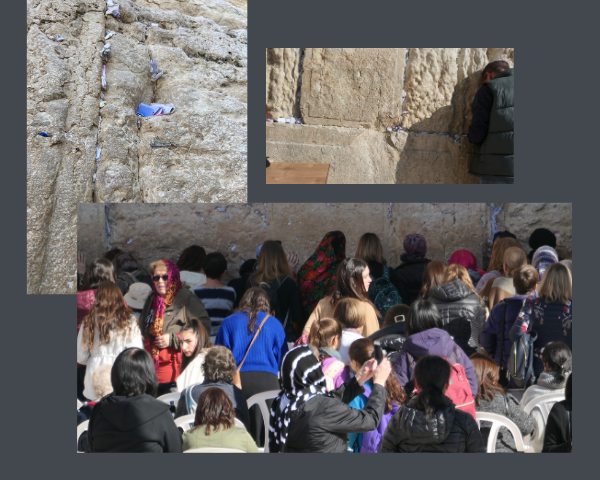
Praying among my unknown sisters at the Wailing Wall
The rock did not hear my whisper. I tried to press my prayer, on a rolled-up notecard, into a small crevice, but the rock could not open to receive it. Sadly, my effort to place my prayer dislodged another woman’s prayer. Again, in my effort to replace her prayer, another fell to the ground.
The ground along the length of the stone wall was littered with prayers, rolls that had been diligently scribed, coiled, and carefully placed by hopeful hands. Piles of unopened rolls lay silent before the face of a three-millennium old city wall of chiseled, cold, and hard stones. Pigeons perched in the outcropping above paid no notice.
I stepped back from the wall carefully, trying not to crush the scraps of prayers around my feet. I sat for a while in the women’s section. I had been told that each night the area is swept clean to prepare for the next day’s faithful pilgrims.
Tomorrow those unfortunate prayers would be gone, swept away, and bagged with trash, from petition to the Almighty God to trash in just one sweep.
I wondered as I sat there, “What if that was my only hope for my petition; the prayer that I had prayed for my family, my friends, for someone just like you?
Gratitude overwhelmed me as I recalled what I knew to be true. Nothing in heaven or on earth can sweep away my silent, spoken, or written petitions and praises from my God’s presence.
The Wailing Wall had been an experience to treasure
but it surely was not the hallowed moment
on a hallowed place that I sought.
Perhaps I would have to wait for the Mount called Golgotha. So far, I had felt more connected to the historical Jesus in the Galilean countryside than in this noisy, bustling city.
Following a Trail of Suffering and Trials
At the House of Caiaphas, the High Priest who orchestrated Jesus’s trials, we descended to the dungeon beneath the house where Jesus was held overnight. It was painful to see the ceiling-mounted wrist straps for binding prisoner’s hands above their head. A little carved out space in the floor was visible below the straps, designed to catch the prisoner’s blood. Blood from Jesus’s wounds had dripped there.
The Jesus who I profess belief in suffered there – for me.
That scene is still hard to fully comprehend.
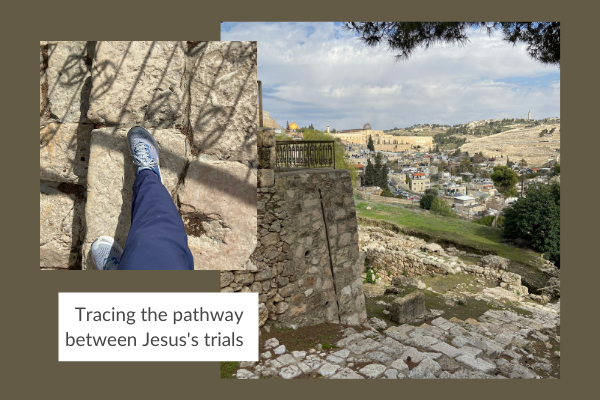
Outside of Caiaphas’s house, I stood at the top of the actual stone stairs that led from this place down to the city. This pilgrimage site is not just “probably the site” but well-known to be the actual place. The temple mount was clearly visible from that vantage point. Jesus had traversed those very steps as he went between his trials with the Jewish leaders and Pontius Pilate.
I have no words for the feeling that rivetted me there. I would have stayed, but the bus was ready to drive away. So, I bent and sorrowfully laid my palm over his imagined footprint.
This was not the hallowed ground that I sought.
Wickedness had its moment there 2,000 years ago.
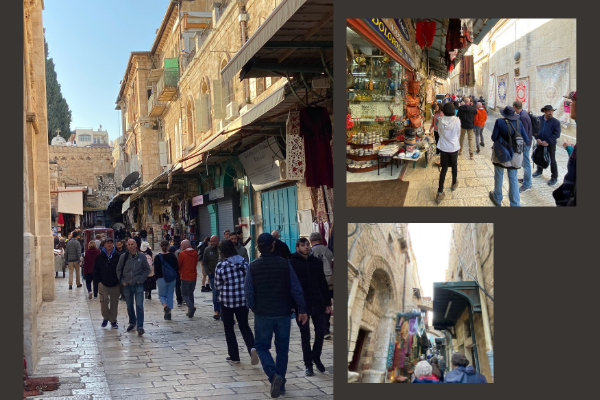
Dodging merchants and foot traffic on the Via Dolorosa
Walking the Via Dolorosa
Marked with its Stations of the Cross, the Via Dolorosa was next in line to defy my expectations. Why, all my life, had I pictured Jesus’s walk up to Mount Calvary as a more solitary journey through a valley? Not so! Shop keepers hawked their wares; mopeds zipped between us. No reverence abode there.
My quest for hallowed ground was defeated again. There was no time or place for meditative thoughts. Keep moving, please. Watch for traffic, please. And please, no shopping right now.
The stones of the Via Dolorosa paid no regard for those who traversed them.
Cobbled, hard, and cold,
these stones were just made for walking.
Jesus did not walk uphill along that narrow way in solemn quietness flanked only by soldiers, Simon of Cyrene, and perhaps a few bystanders. He was pushed and jostled among a thronging crowd, mindless mockers with no reverence or recognition of the divine.
Our two-week journey ended not far from there. This time it was in a quiet garden. But still, it ended with stone.
Hewn stone shaped into a cave-like tomb.
Ancient Stones: Cold and Hard, as always.
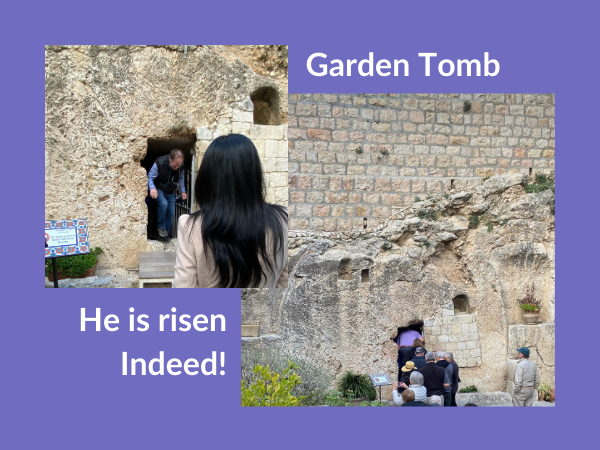
Waiting for a Glimpse of Glory
The line is long to get a glimpse. You enter and exit through the same small doorway, one by one. Just one glimpse is really all that is needed. You do not even need multiple photos. There is absolutely nothing to see inside but emptiness. A cold hard slab that is completely void of life.
Iron bars prevent visitors from entering the carved-out slab where His body would have laid. But you see it just before you. You see the place where his head would have laid. But mostly, you see a space that contains only space.
The moment is surreal. Should I cry? Should I shout Hallelujah? Or silently kneel and pray? I am surrounded by everything and nothing all at once. The greatest universal force, resurrection power, had burst inside this now empty, silent space. How could this burial chamber feel so void now?
Like everyone else in line who entered before or after me, my allotted time to glimpse the tomb fleeted too quickly. Of course, I touched the stone wall and bent to lay my palm on the floor before ducking through the doorway to exit.
Once again, even these ancient stones were just:
Ancient, Cold, and Hard.
Because – the miracle had left the building.
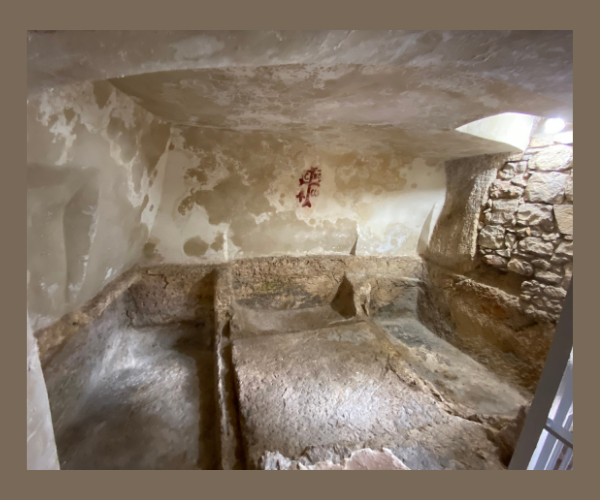
Inside the empty tomb of Jesus
The tomb is empty, veritably empty.
The stone is rolled away to prove it.
Jesus had walked away from the slab, ducked through the doorway, and exited into the garden surrounding the tomb.
But because the tomb is empty for almost 2000 years, the first shout of resurrection morning continues to resound around the globe:
Alive! Their Jesus, Our Jesus,
My Jesus is alive!
As joyfully energizing as that knowledge is, my exit from the tomb was deeply somber. The enormity of his life, suffering, death, burial, and resurrection was swirling in my mind and emotions. Others appeared somber also as we waited to gather for a worship time where our tears and joy could freely flow together.
Oddly though, even here at the Garden Tomb, there was no truly “hallowed” aura about the space itself, except for our memory of the place.
The “hallowedness” is only found in what we make of that memory.
It cannot become holy until we blend that memory with our personal experience of a risen Savior who gives light and life to all who will believe in Him.
I realized that even if I could have touched the cold slab where Jesus body was laid after his crucifixion, my sensory report would have been the same as on day one of our trip:
“Ancient stones: Cold and Hard.”
Final Reflections
That thought triggered new reflections.
I remembered that during his life on earth, all the animate and inanimate things which Jesus touched did not automatically become hallowed (holy). His touch had made people whole.
It was the touch of his hands, with the word he spoke, that brought healing to the sick, sight to the blind, hearing to the deaf, life to the dead, freedom to the demon-possessed, and eternal life to all who would believe.
The dynamic of our tour was not the magnificent, ancient stones but the Word.
Every stone I touched was the same:
Cold and Hard. Lifeless and silent.
But every time the group paused to listen to the Word, whether the reading of the Bible or a devotional thought from the Word, then a feeling of warmth and life pervaded the group.
The life was in the Word.
My hallowed place was found in the Word, His Word,
not in the ancient stones or places where we traced His footsteps.
Jesus said to her, “I am the resurrection and the life. Whoever believes in me, though he die, yet shall he live.” John 11:25 (ESV)

